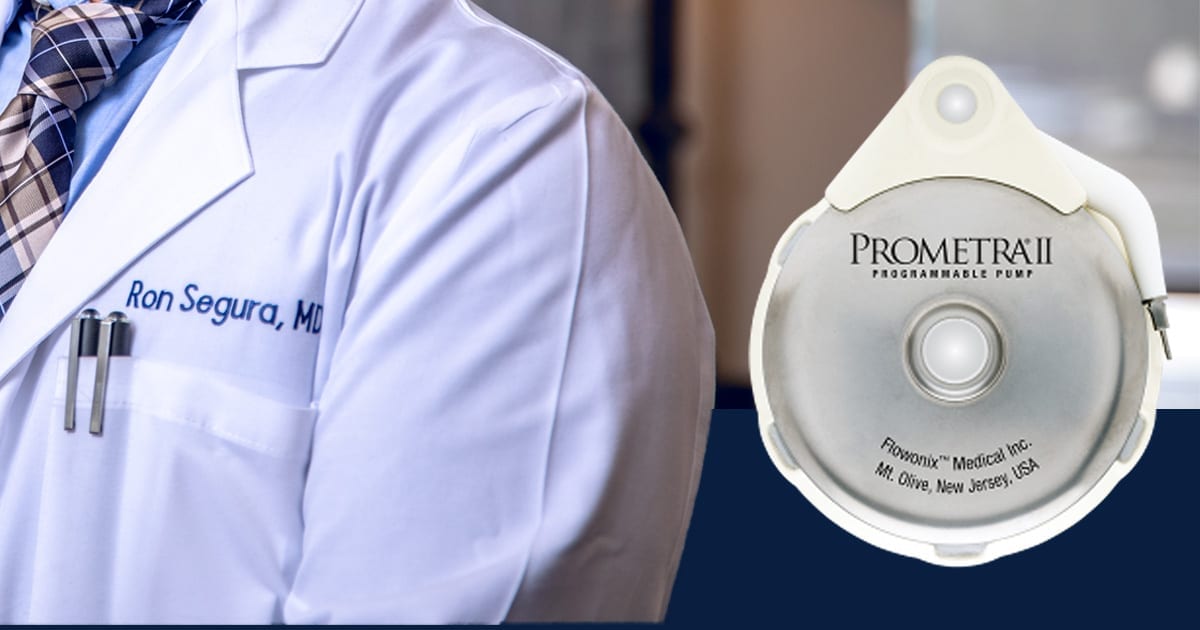
The intrathecal pain pump has been around for years. However, advancements in technology have made them an ideal treatment option for many patients. Dr. Ronald C. Segura is the first doctor in Louisiana to implant the Prometra® II 40 mL programmable pump. In today's blog post, we'll discuss how this treatment can provide relief for patients who may have run out of surgical options, but are still suffering from chronic pain.
How an Intrathecal Pain Pump Works
An intrathecal pain pump is a method of delivering medication directly to the area around the patient’s spinal cord. A small pump, about the size of a hockey puck, is implanted under the skin, typically in the abdomen. A catheter is attached to the pump. The other end is placed in the intrathecal space – the area around the spinal cord. The pump is then programmed to dispense a precise dose of medication to the pain receptors in the problem area. This treatment interrupts any pain signal trying to go to the brain. The result is a significant reduction in pain.
“This treatment interrupts the pain signal trying to go to the brain. The result is a significant reduction in pain.”Dr. Ronald C. Segura
The Benefits of Pain Pumps
No Systemic Side Effects
With an intrathecal pain pump there are no "systemic side effects," since medication is slowly delivered directly to the pain site. Patients needn’t worry about kidney or liver damage, constipation or other symptoms associated with oral medications.
No Risk of Addiction
Pain pumps also promise less risk of building a tolerance to medication, and patients won’t develop a debilitating addiction. "When you give medication spinally, it does not cross the blood-brain barrier,” Dr. Segura says. “It doesn't give patients the same pleasurable high as an opioid pill.”
Delivery of Medication While You Sleep
The pain pump works overnight, so patients sleep better. Imagine waking up and not having to take an oral dose of medication. That means fewer morning symptoms, or suffering through an initial period of pain waiting for the morning oral dose to take effect.
Pain Pumps are Reversible
When used as directed, the intrathecal pain pump has been proven to be safe and effective. The procedure does not involve permanent changes to the spinal cord or nerves. And, the therapy is reversible. It can be turned off, or if necessary, it can be surgically removed.
New Technological Breakthroughs
The Prometra II 40 mL programmable intrathecal pain pump has been enhanced with a larger medication reservoir compared to the older 20 mL version. This improvement may reduce the frequency of refill appointments, which can be especially important to patients who have difficulty getting to healthcare because of mobility or transportation issues.
Another critical advance with the Prometra II 40 mL programmable pump is an improved battery life of up to 10 years at average flow rates, a feature which might potentially lessen the number of replacement surgeries. The new pain pump also has an updated programming platform, building on the already easy-to-use Maestro Programmer system.
“The larger medication resevoir can reduce the frequency of refill appointments, which can be especially important to patients who have difficulty getting to healthcare because of mobility or transportation issues.”Dr. Ronald C. Segura
Is a Pain Pump Right for You?
If conservative and surgical approaches have failed to reduce your pain, an intrathecal pain pump may be ideal for you.
Contact us today to schedule an appointment with Dr. Segura or Dr. Robertson. They can identify the root cause of your pain, review your history and treatments, and tell you if you’re a good candidate for pain pump therapy.
This website is not intended to provide specific medical advice, medical diagnosis, opinion, treatment or services to you or to any other individual. Through this website and links to other websites, Segura Neuroscience & Pain Center provides general information for educational purposes only. The information provided in this site is not a substitute for medical or professional care. You should not use this information in place of the advice of your physician or other healthcare provider. Segura Neuroscience & Pain Center is not liable or responsible for any advice, course of treatment, diagnosis or any other information, services or product you obtain through this website.
